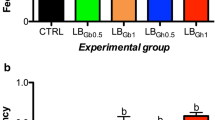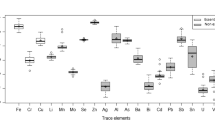Abstract
Historically farmed fish were frequently found to exhibit a lower ratio of n3/n6 fatty acids compared to wild fish. This study compares the proximate and fatty acid composition of wild and cultured gilthead sea bream fish from a lagoon in NW Greece. Wild fish contained less fat and showed different fatty acid profiles. Farmed fish exhibited threefold higher concentrations of linoleic acid (C18:2n-6) in muscle and twofold in visceral fat. Their muscle tissue contained higher levels of saturated fatty acids and higher ratios of eicosapentaenoic acid/docosahexaenoic acid (0.49 ± 0.04 vs. 0.03 ± 0.01; Ρ < 0.001). Wild fish exhibited lower levels of muscle n-3 fatty acids (15.87 ± 0.82 vs. 19.89 ± 1.06; P < 0.001) but a higher ratio of n-3/n-6 (2.22 ± 0.14 vs. 1.64 ± 0.10, Ρ < 0.001). These results emphasize the need to further explore dietary manipulation of fatty acid content as a method of improving the fatty acid profile and maximise the health benefits of consuming farmed fish.

Similar content being viewed by others
References
Alasalvar C, Taylor KDA, Zubcov E, Shahidi F, Alexis M (2002) Differentiation of cultured and wild sea bass (Dicentrarchus labrax): total lipid content, fatty acid and trace mineral composition. Food Chem 79:145–150
Benedito-Palos L, Navarro JC, Bermejo-Nogales A, Saera-Vila A, Kaushik S, Perez-Sanchez J (2009) The time course of fish oil wash-out follows a simple dilution model in gilthead sea bream (Sparus aurata L.) fed graded levels of vegetable oils. Aquaculture 288:98–105
Bligh EG, Dyer WY (1959) A rapid method of total lipid extraction and purification. Can J Biochem Physiol 37:911–917
Borresen T (2008) Seafood plus—how to provide health promoting, safe seafood of high eating quality to consumers. Journal fur Verbraucherschutz und Lebensmittelsicherheit 3:15–18
Cakli S, Kilinc B, Dinger T, Tolasa S (2008) Shelf life of new culture species (Diplodus puntazo) in refrigerator. J Muscle Foods 19:315–332
Carpene E, Martin B, Dalla-Libera L (1998) Biochemical differences in lateral muscle of wild and farmed gilthead sea bream (Sparus aurata L.). Fish Physiol Biochem 19:229–238
Din JN, Newby DE, Flapan AD (2004) Omega 3 fatty acids cardiovascyuar disease- fishing for a natural treatment. Brit Med J 328:30–35
Eggleston D (1975) Determination of age of kahawai Arripis trutta (Bloch & Schneider). New Zealand J Mar Fresh Res 9:293–298
FAO (2004) The state of world fisheries and aquaculture: (2004) FAO, Rome. ftp://ftp.fao.org/docrep/fao/007/y5600e/y5600e00.pdf)
Folch J, Less M, Stanley GHS (1957) A simple method for the isolation and purification of total lipids from animal tissues. J Biol Chem 226:457–509
George R, Bhopal R (1995) Fat composition of free living and farmed fish species: implications for human diet and sea farming techniques. Br Food J 97:19–22
Grigorakis K (2007) Compositional and organoleptic quality of farmed and wild gilthead sea bream (Sparus aurata) and sea bass (Dicentrarchus labrax) and factors affecting it: a review. Aquaculture 272:55–75
Grigorakis K, Alexis MN, Taylor KDA, Hole M (2002) Comparison of wild and cultured gilthead sea bream (Sparus aurata); composition, appearance and seasonal variations. Intern J Food Sci Technol 37:477–484
Grigorakis K, Taylor KDA, Alexis MN (2003) Organoleptic and volatile aroma compounds comparison of wild and cultured gilthead sea bream Sparus aurata): sensory differences and possible chemical basis. Aquaculture 225:109–119
Huidobro A, Pastor A, Lopez-Caballero ME, Tejada M (2001) Washing effect on the quality index method (QIM) developed for raw gilthead sea bream. Eur Food Res Technol 212:408–411
Izquierdo M, Obach A, Arantzamendi L, Montero D, Robaina L, Rosenlund G (2003) Dietary lipid sources for seabream and seabass: growth performance, tissue composition and flesh quality. Aquacult Nutr 9:397–407
Izquierdo MS, Montero D, Robaina L, Caballero MJ, Rosenlund G, Ginés R (2005) Alterations in fillet fatty acid profile and flesh quality in gilthead seabream (Sparus aurata) fed vegetable oils for a long term period. Recovery of fatty acid profiles by fish oil feeding. Aquaculture 250:431–444
Keli SO, Freskens EJM, Kromhout D (1994) Is fish consumption inversely associated with stroke incidence? The Zuptkin study. Stroke 25:328–332
Kinsella JE, Shimp JL, Weihrauch J (1977) Fatty acid content and composition of freshwater finfish. J Am Oil Chem Soc 54:424–429
Kolditz C, Borthaire M, Richard N, Corraze G, Panserat S, Vachot C, Lefevre F, Medale F (2008) Liver and muscle metabolic changes induced by dietary energy content and genetic selection in rainbow trout (Oncorhynchus mykiss). Am J Physiol Integr Comp Physiol 294:R1154–R1164
Koven WM, Tandler A, Sklan D, Kissil GW (1993) The association of eicosapentaenoic and docosahexaenoic acids in the main phospholipids of different-age Sparus aurata larvae with growth. Aquaculture 116:71–82
Kris-Etherton PM, Taylor DS, Yu-Poth S, Huth P, Moriaty K, Fishell V, Hargrove RL, Zhao G, Etherton TD (2000) Polyunsaturated fatty acids in the food chain in the United States. Am J Clin Nutr 71:179S–188S
Lenas D, Loghothetis P, Kanlis G, Nathanailides C (2010) Comparison of fatty acids in the brains of wild and reared sea bass Dicentrarchus labrax L. and sea bream Sparus aurata L., and living in the same natural environment. Inter Aquat Res 2:135–141
Lloret J, Galzin R, De Sola LG, Souplet A, Demestre M (2005) Habitat related differences in lipid reserves of some exploited fish species in the north-western Mediterranean continental shelf. J Fish Biol 67:51–65
Lloret J, Demestre M, Sanchez-Pardo J (2007) Lipid reserves of red mullet (Mullus barbatus) during pre-spawning in the northwestern. Mediterranean Scienta Mar 71:269–277
Martinez-Llorens S, Tomas A, Andris V, Morino V, Torres MP, Cerda JM (2007) Effects of dietary soybean oil concentration on growth, nutrient utilization and muscle fatty acid composition of gilthead sea bream (Sparus aurata L.). Aquac Res 38:76–81
Mattissek R, Schnepel MF, Steiner G (1992) Lebensmittel Analytik. Grundzuge. Methoden, Anwendungen, 2nd rev. Springer, Berlin
Metchalfe LD, Schmitz AA, Pelka JR (1966) Rapid preparation of fatty acids esters from lipids for gas chromatography analysis. Ann Chem 38:524–535
Mnari A, Bouhlel I, Chraief I, Hammami M, Romdhane MS, El Cafsi M, Chaouch A (2007) Fatty acids in muscles and liver of Tunisian wild and farmed gilthead sea bream, Sparus aurata. Food Chem 100:1393–1397
Nathanailides C, Paschos I, Tsoumani M, Perdikaris C, Kapareliotis A (2009) Capacity for thermal acclimation and winter mortality of sea bass (Dicentrarchus labrax) in freshwater earthen ponds. Ital J Zool 77(1):23–28
Nathanailides C, Lopez-Albors O, Lenas D, Grigorakis K, Athanassopoulou F (2010) Changes in cytochrome c oxidase and lactate dehydrogenase enzyme activity in white epaxial muscle as shelf-life predictive indices during ice storage of sea bass (Dicentrarchus labrax L.). Ital J Food Sc 22:200–204
Orban E, Nevigato T, Di Lena G, Casini I, Marzetti A (2003) Differentiation in the lipid quality of wild and farmed sea bass (Dicentrarchus labrax) and Gilthead sea bream (Sparus aurata). J Food Sci 68:128–132
Panella G (1971) Fish otoliths: daily growth layers and periodical patterns. Science 173:1124–1126
Pauly D, Christensen V, Guenette S, Pitcher TJ, Sumaila UR, Walters CJ, Watson R, Zeller D (2002) Towards sustainability in world fisheries. Nature 418:689–695
Quinton CD, McMillan I, Glebe BD (2005) Development of an Atlantic salmon (Salmo salar) genetic improvement program: genetic parameters of harvest body weight and carcass quality traits estimated with animal models. Aquaculture 247:211–217
Roche H, Peres G (1984) Influence of acclimatization to different temperatures and of the seasonal factor on the lipid-composition of liver, muscle and intestinal tissues of sea dace bass (Dicentrarchus labrax). Comp Biochem Physiol B78:755–759
Rodriquez C, Perez JA, Badia P, Izquirdo MS, Fernadez-Palacios H, Hernadez AL (1998) The n-3 highly unsaturated fatty acids requirements of gilthead seabream (Sparus aurata L.) larvae when using an appropriate DHA/EPA ratio in the diet. Aquaculture 169:9–23
Saglik S, Alpasian M, Gezgin T, Cetinturk K, Tekinay A, Guven KC (2003) Fatty acids composition of wild and cultivated gilthead sea bream, (Sparus aurata) and sea bass, Dicentrarchus labrax. Eur J Lipid Sci Technol 105:104–107
Sargent JR (1997) Fish oils and human diet. Br J Nutr 78:S5–S13
Shapira N, Weill P, Sharon O, Loewenbach R, Berzak O (2009) n-3 PUFA fortification of high n-6 PUFA farmed tilapia with linseed could significantly increase dietary contribution and support nutritional expectations of fish. J Agric Food Chem 57:2249–2254
Simopoulos AP (2002) The importance of the ratio of omega-6/omega-3 essential fatty acids. Biomed Pharmacother 56:365–379
Stansby ME (1981) Reliability of fatty acid values purporting to represent composition of oil from different species of fish. J Am Oil Chem Soc 58:13–16
Stirling report (2004) Stirling Institute of Aquaculture Study of the market for aquaculture produced sea bass and sea bream species. Report to the European Commission, DG Fisheries
Tanakol R, Yazici Z, Sfener E, Senger E (1999) Fatty acid composition of 19 species of fish from the Black Sea and the Marmara Sea. Lipids 34:291–297
Torstensen BE, Froyland L, Ornsrud R, Lie O (2004) Tailoring of a cardioprotective muscle fatty acid composition of Atlantic salmon (Salmo salar) fed vegetable oils. Food Chem 87:567–580
Van Vliet T, Katan MB (1990) Lower ratio of n-3 to n-6 fatty acids in cultured than wild fish. Am J Clin Nutr 51:1–2
Wallace FA, Miles EA, Calder PC (2003) Comparison of the effects of linseed oil and different doses of fish oil on mononuclear cell function in healthy human subjects. British J Nutr 89:679–689
Yildiz M, Sener E, Timur M (2007) Effects of differences in diet and seasonal changes on the fatty acid composition in fillets from farmed and wild sea bream (Sparus aurata L.) and sea bass (Dicentrarchus labrax L.). Int J Food Sci Technol 43:853–858
Acknowledgments
The authors are grateful to Dr. A. Rowlerson, Centre for Applied Biomedical Research, King’s College London, for comments and suggestions on an earlier version of this manuscript.
Author information
Authors and Affiliations
Corresponding author
Rights and permissions
About this article
Cite this article
Lenas, D.S., Triantafillou, D.J., Chatziantoniou, S. et al. Fatty acid profile of wild and farmed gilthead sea bream (Sparus aurata). J. Verbr. Lebensm. 6, 435–440 (2011). https://doi.org/10.1007/s00003-011-0695-2
Received:
Accepted:
Published:
Issue Date:
DOI: https://doi.org/10.1007/s00003-011-0695-2




